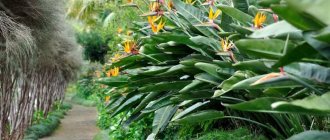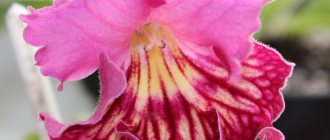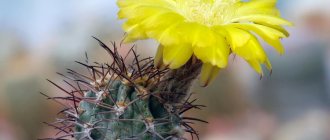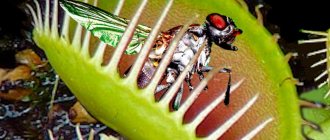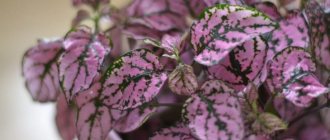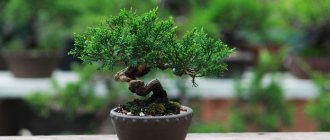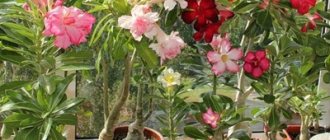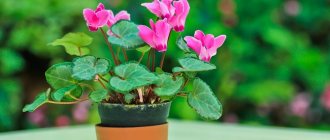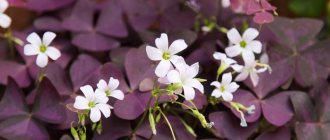Carnivorous plants arouse great curiosity and interest among people. This is because they are unusual and very attractive looking. One of them is the Venus flytrap, a predatory exotic plant whose wild forms grow on the marshy coast of the Atlantic Ocean.
Fans of indoor floriculture all over the world want to get their hands on this flower for cultivation. But is it possible to grow a Venus flytrap from seeds? You will find answers to this and other questions about flower care by reading this material.
What kind of flower is this
This plant has been known to people for 300 years. The study of this insect hunter began in the 18th century. The flower has several names. He received one of them for his attractiveness in honor of Dionea, who was the mother of the beautiful Aphrodite.
People at all times have tried to introduce this miracle of nature into pot culture. When it became clear what conditions were needed to grow dionaea at home, it began to decorate the windowsills of many houses. A flower in an apartment performs 2 important functions. Due to its decorative nature, it decorates the room. In addition, it relieves owners from annoying mosquitoes and flies.
Description and characteristics
The Venus flytrap, or Dionaea, is a genus of carnivorous plant. Its wild forms are found on the Atlantic coast of the United States. Grows in marshy, moist soils. Swampy peatlands contain little nitrogen, but this is not a problem for Dionaea, since it receives this nutrient from its victims.
The species is represented by low-growing herbaceous forms that do not have a trunk. The plant has a short underground stem, from which 4 to 7 leaves grow, collected in a rosette.
The length of the leaves ranges from 3.5 to 7 cm. Outwardly, they look like traps with spikes along the edge. The color of the leaves is light green, and their inner surface is painted in red tones. They emit a smell that attracts insects. In addition, the leaves produce special enzymes that help digest caught insects.
The insect trap is made of 2 sheets, which have hairs along the edge for stronger adhesion to each other when the trap slams shut. The insect, attracted by the smell of nectar, lands on the inner petals. This causes irritation of special signal hairs, and the trap quickly slams shut.
When the leaf blades completely close, a cavity is formed with the function of a stomach. The food obtained is digested and absorbed in this cavity. This takes 7-10 days. Then the trap opens again and the plant is ready to capture the next victim. In the natural environment, the Venus flytrap preys on insects and mollusks. Each trap can catch and digest 3 victims, and then it dies.
With the onset of winter, the appearance of Dionaea changes. Its leaves die and it seems that the flower has died. However, with the advent of the first rays of the sun, the carnivorous plant comes to life again and prepares for the hunt. Under good conditions, Dionaea can live 20 years.
How does slamming happen?
The main attraction is the red color of the traps, achieved by a pigment called anthocyanin. The cells also secrete a sticky protein. Once trapped, the prey immediately begins to flounder and slide on the sticky surface, simultaneously trying to consume more of this protein. In this case, the victim invariably touches the trigger hairs, and they signal that it is time to close the trap.
There are four phases of the Dionaea trap closing:
“Trigger hairs” are essentially a signal for Dionaea, which senses from their vibrations that food has fallen into a natural trap.
Important! If two hairs vibrate at once or one of them vibrates twice with an interval of no more than half a minute, it takes one tenth of a second for the trap to close.
Closing a Dionaea trap is one of the fastest movements of representatives of the plant kingdom. The duration of the slamming process is determined by many factors. For example:
However, a healthy Dionaea in good conditions collapses extremely quickly.
If you dig into it, the details of this process are complicated. Now scientists are researching how this is done and building hypotheses. These include an immediate increase in cell size and a subsequent “unstable snapping state,” entirely controlled by the plant.
In 2005, Harvard conducted research that made it clear that the trap is slammed shut mainly by elastic and biochemical processes.
Important! Because of them, the tissues of the trap leaf stretch until they become unstable, and then, when an insect touches the hairs, the plant instantly pumps water into the leaf, and this automatically closes the trap.
Compression phase
If the initial collapse is successful, the plant begins the contraction phase. It takes about thirty minutes. At the same time, the victim tries to get out, touches the “alarm” again and again, and the plant clamps the doors further and further, thereby preventing the victim from getting out. Otherwise, those insects that are quite small can break out and move away.
When the insect begins to flounder, it provokes the plant to tighten its grip on the trap.
But if the plant’s “hunt” fails, the compression phase does not begin. This is possible if the victim manages to escape from the trap or the hairs move due to factors not related to insects:
In these cases, the trap slowly opens, and after a day or two it is again ready to receive insects. However, if the “hunt” is repeatedly unsuccessful, the trap will turn black and die.
Important! Even if she survives, she collapses more and more slowly each time.
Sealing and opening phases
Upon successful capture and capture of the victim, the Dionaea begins to seal the trap. The teeth move forward and outward, no longer intertwining. Then the edges of the valves begin to press against one another. When the seal is sufficiently tight, digestive enzymes begin to be released, sinking and digesting the prey.
Then the trap remains closed for a period of five to twelve days, all this time digesting the caught prey. During this time, enzymes are released there to dissolve the soft tissues of the prey. Nutrients from the insect body are processed so that the plant can finally use them as food.
The plant can digest its prey for about a week, sometimes longer.
The period of complete digestion is determined by three factors:
Ideally, you want the caught victim to fill the trap space by a third. An overly large “dish”, as well as the part of it hanging from the trap, will prevent this very trap from being tightly sealed. Then the trap turns black, dies, and then falls off. The base part of the leaf will continue to perform the same role as the ordinary foliage of other plants, receiving energy from the sun's rays, but traps for catching insects will no longer appear on it.
During “eating,” the leaf absorbs not only nutrients, but also digestive fluid. Lowering the trap signals to the plant that it is time to open it again. All that remains of the victim is the external skeleton. It may not remain trapped by being washed away by rain or blown away by the wind.
Important! However, the skeleton may remain where the insect died, in which case it will be a bait for spiders or ants. Then they will also go to the plant for breakfast, lunch and dinner.
The trap only works a few times and then dies. The rest of the plant, if cared for, can live up to a couple of decades.
Is it possible to grow it at home?
Since humanity discovered this wonderful flower, attempts have been made to introduce it into culture. Over time, it became clear what conditions were needed to grow Venus flytraps on windowsills. Now Dionaea can be found in many homes where it grows successfully.
Optimal growing conditions
Dionaea reacts very sensitively to unsuitable growing conditions. When growing it at home, all care work must be carried out in a timely manner and a comfortable microclimate must be created. The following describes what requirements a carnivorous plant makes for normal development.
- Lighting. The light should be bright enough, but diffused. The sun's rays in this form should fall on the flower for 5 hours, mainly in the morning and in the evening. The sun can cause the Venus flytrap's root system to overheat. To prevent this, the pot is wrapped in reflective material. With a lack of light, the leaves turn pale and the plant stretches. The problem can be solved by installing additional lighting with fluorescent lamps.
- Place for a potty. Dionaea grows best on the windowsills of eastern or western windows. If there is no such accommodation option, and the apartment’s windows face south, it’s not a problem. Place the pot on a south-facing window and provide shade. Dionaea reacts poorly to movements, so you need to immediately find a suitable place for it.
- Air exchange. Fresh air has a beneficial effect on the Venus flytrap. In summer, you can take the flower pot out onto the loggia or even into the garden. If both are not available, you need to regularly ventilate, avoiding drafts.
- Room temperature. This genus belongs to heat-loving plants. In the warm season of the year, it is necessary to provide the dione with a temperature range of 23-30 degrees above zero, and in winter +10 degrees is enough.
- Irrigation. Both waterlogging and drying out of the soil should not be allowed. The top of the soil is constantly kept slightly moist. To preserve moisture, mulching with moss is a good idea. Irrigation is best carried out using the bottom watering method, when the calculated amount of water is poured into the pan. In extreme heat, you need to humidify the air around the flower with a spray bottle.
- Rest period. In autumn, the plant enters a dormant period. Its leaves dry out, turn black and fall off. Externally, the flower seems lifeless. There is no need to panic or take any resuscitation actions, since this is a natural process. You just need to move the pot of dionaea to a dark, cool place and wait until mid-February, sometimes moistening the soil. With the arrival of spring, active growth of the Venus flytrap will resume.
Transfer
The plant is replanted every 2-3 years after the winter dormancy period. This is usually done in April before growth begins.
Choose a container for the flower that is not too spacious, only 1 cm wider than the old pot. Drainage made of brick chips is laid at the bottom.
Dionaea is replanted using the transshipment method so as not to injure the root system.
In this case, it is advisable not to touch the surface of the trap leaves so that they do not begin to close. After transplantation, the flower is watered and placed in partial shade for a week.
Where to get seeds
Venus flytrap seeds can be obtained independently from an adult plant or purchased at commercial gardening centers. If your friend has Dionaea and you are going to take seeds from it for propagation, then you will have to work hard. At home, seeds can only be grown using artificial pollination.
Getting your own seeds
In the spring, when Dionaea enters the flowering phase, you need to use a paint brush to transfer pollen from one plant to another. The flower will be fertilized and after 30 days the ovaries will appear. The fruit of Dionaea is a capsule containing from 20 to 30 black shiny achenes. The ripened seeds are stored in the refrigerator in paper bags. They will become suitable for sowing 150 days after harvest.
Important! For artificial propagation, a plant that has already overwintered at least once is suitable.
Is it possible to order from China on Aliexpress?
In recent decades, with the development of the Internet, seeds began to be ordered through the World Wide Web. On the Internet you can find quite a lot of online stores that sell seeds of vegetables, berries and exotic plants. You can order Venus flytrap seeds there.
One of the most popular online stores is Chinese Aliexpress. Dionaea seeds can be ordered there. However, it is worth mentioning that sometimes those who order Venus flytrap seeds receive bags with completely unknown plants, and sometimes they send weed seeds.
Structure of the fishing apparatus
The length of one trap is 5-15 cm. It is formed from two slamming flaps, on which bristles and trigger hairs are located.
The outer part of flyeater traps is often green, less often red. Internal is the opposite. The color saturation depends on the variety and lighting level.
The trap leaves contain glands that produce nectar with a pleasant aroma. This substance is sticky, so an insect that touches it cannot quickly get out.
In addition, such trap leaves glow in the dark with a pale blue light. All this helps attract insects.
Closing mechanism
The predatory plant Venus flytrap understands that an insect has entered by touching the sensitive hairs of the leaf.
For an action potential to arise and triggering, a touch with a force of 0.05 mN is sufficient. But it must be directed at the right angle.
This restriction prevents accidental slamming due to raindrops, the touch of large animals or humans, etc.
If a false alarm does occur, the trap will open only after a few days. And if this happens often, she may die.
You can see how the Venus flytrap reacts to irritation of trigger hairs in the video below.
Compression phase
If a edible insect actually gets into the trap, it continues to fight even after it slams shut. Constant stimulation of the sensitive hairs “tells” the plant that the hunting goal has been achieved. As a result, the trap is compressed more strongly.
If the trigger was false or the Dionaea caught a fly that was too small to escape between the teeth of the trap, compression will not occur.
Digestion phase
After the trap is sealed, the leaf glands begin to produce digestive juice. Over time, it will dissolve the fly or other insect so that the Venus flytrap can absorb the nutrients.
The duration of the digestion process reaches 12 days. Its speed depends on 3 factors:
- insect size;
- age of the Venus flytrap;
- air temperature.
When the prey is digested, the trap opens wide. In nature, insect remains are washed away by rain or carried away by the wind. At home, the grower must remove them himself.
After a few more days, the trap comes into an active, half-open state and is ready to accept a new victim.
Preparing for landing
Not everyone can grow a Venus flytrap from seeds, as it is quite difficult. Young flowers may die due to lack of light or insufficient air humidity. Therefore, it is very important to carry out all pre-sowing preparatory work correctly.
Preparing the seeds
Regardless of what seeds are used for sowing - purchased or grown independently, they must be properly prepared before the planting procedure.
Before planting, seed material must undergo a stratification process, which significantly increases seed germination. The essence of stratification is as follows:
- moisten a cloth in a 1% solution of potassium permanganate;
- dry Dionaea seeds are laid out on it;
- send the seeds to the refrigerator, where the temperature is maintained at 3 to 5 degrees Celsius;
- stratification lasts 2 months and during this time you need to regularly wet the cloth;
- By the end of the process, subtle cracks will appear on the seed coats, indicating that the seeds are ready for sowing.
Choosing a place
While the seeds are stratified in the refrigerator, you need to decide on the place where the pot of dionaea will be placed. To do this, you should clear the window sill of the western or eastern window, clean and wash it. If the windows of the house face south, then a shading screen should be prepared there to protect the young Dionaea from direct sunlight.
Preparing the soil
We noted earlier that wild Dionaea grows in marshy soils and prefers an acidic environment. This should be taken into account when preparing the soil for it yourself.
The soil must be composed of the following ingredients:
- 2 parts peat;
- 2 parts perlite;
- 1 part moss;
- 1 part sand.
All ingredients are thoroughly mixed until homogeneous, and then the soil is disinfected from fungal diseases with a 1% solution of potassium permanganate.
Selecting and preparing a pot
For Dionaea, choose a small pot with a diameter of 10 cm and a height of 12 cm. Experienced flower growers advise growing a Venus flytrap in a special florarium or in an aquarium. It is easier to maintain the required air humidity and set the correct lighting.
The drainage layer is not placed in the pots, but immediately filled with the prepared soil mixture.
Sowing technology
It is recommended to sow the seeds after February 15 in order to transplant the seedlings into separate pots with the onset of summer.
The sowing procedure is performed according to the following algorithm:
- sow the seeds on the surface of the soil without deepening them; you can sprinkle them with moss;
- water with a spray bottle carefully so as not to brush them off the surface;
- cover the pots with plastic wrap;
- maintain the temperature background at 24-28 degrees Celsius;
- illuminate the crops at least 15 hours a day;
- Do not allow the soil to dry out when watering.
Important! If all the points on the list are followed, the seedlings will appear in 2 or 3 weeks. The film is removed at this time.
Further care
When 2 true leaves appear on the plant, it is necessary to begin hardening. They do this gradually, opening the film shelter for a short period of time. The temperature in the room at this time should not fall below +18 degrees. First, the film is opened slightly for 5 minutes, and then the exposure is gradually increased to 20 minutes.
When Dionaea has 3-5 true leaves, it is transplanted into individual pots. The transplantation procedure is performed with great care, remembering that the Venus flytrap has fragile roots. Dionaea grows very slowly and will become an adult plant only after 5 years.
Watering
When growing a Venus flytrap, you need to constantly monitor the soil moisture. You should not allow it to dry out even for a short time, as this is detrimental to the flower.
It is not advisable to use top watering for moisture, because this method makes it difficult for oxygen to reach the roots. Water should be poured into the pan so that its level is above the drainage holes in the pot. The plant itself will take the required amount of moisture from the pan.
For irrigation, it is better to use rainwater or distilled water. Watering frequency - 3 times a week.
Fertilizer
Fertilizing in the form as we understand it is not carried out in relation to Dionaea. The plant does not need root or foliar fertilizing with fertilizers.
It is better to take care that Dionaea can constantly hunt and maintain a sufficiently humid environment for it.
Feeding
The Venus flytrap is a predator that obtains all the necessary nutrients from the digestion of its victims.
For feeding to be successful, you need to follow some rules:
- It is enough to feed Dionaea once a month. During the entire growing season, she needs to digest 3 insects. Mosquitoes, spiders or flies are suitable as food.
- The size of the victim should not be larger than the size of the trap.
- Worms, leaf-eating insects and insects with a chitinous hard shell are not suitable for food.
- You cannot feed the flower pieces of meat and other foods from the table.
- It is highly undesirable to feed Dionaea in the following cases:
- if the flower is sick;
- when replanting a plant;
- when the soil is waterlogged;
- in poor lighting.
Important! In late autumn and during winter, feeding is temporarily stopped.
Transfer
After sowing the seeds, the first flower transplant is carried out 2 years later. Then this procedure is repeated with the same frequency. The best time for transplantation is spring.
The transplant procedure is performed according to the following rules:
- the new pot should be deep enough, but not wide, because the roots of Dionaea are quite long;
- the roots of the plant are fragile, replanting should be done slowly and carefully;
- when the Venus flytrap is removed from the pot, the soil should be removed from the roots and washed with water;
- the depleted mixture described above is poured into a new pot.
After transplantation, the plant will need a month to adapt. During this period, it should be well watered and kept in partial shade.
Important! Whether the dionea needs replanting can be determined by the condition of the soil in the pot. If its top layer begins to lag behind the walls and acquires a white coating, it’s time to replant.
Reproduction of Venus flytrap
There are four ways to propagate Dionaea:
- The simplest and most common is the separation of baby bulbs. Once every three years, during transplantation, several daughter bulbs can be separated from the adult flytrap. It is important not to overdo it, because if you separate too many children, the plant will noticeably weaken.
- You can propagate flycatchers from cuttings. In a predator plant it is a leaf without a trap. The process takes about six months.
- As you know, the peduncle takes a lot of energy from Dionea, so it is recommended to cut it off. If you do this before it grows too large, the peduncle can be used as a kind of cutting, rooted and a new flytrap grown from the peduncle.
- Reproduction of the Venus flytrap by seeds is an activity for experienced gardeners. This is a long and uncontrolled process, because the set of genes in the mother plant and the one grown from the seed can differ significantly. Seeds suitable for propagation can only be produced by an adult plant - older than 2-3 years.
Protection from diseases and pests
When growing a Venus flytrap at home, it is extremely rarely attacked by pests. The most common pest is aphids. She settles in traps, sucking plant sap. As a result of its harmful effects, the traps become deformed and lose functionality, the plant cannot hunt and dies. Dionaea can be protected from aphids by treating it with special aerosols.
In addition, the flower may suffer from spider mites. If the air humidity is insufficient, the risk of tick damage increases. These insects are controlled by spraying with a solution of a purchased acaricide.
Due to neglect of the rules for growing the Venus flytrap, the Venus flytrap may become ill with certain diseases. Most often these are the following ailments:
- Mold fungus. Occurs when the air is excessively humidified. Appears in the form of black spots. The disease can be eliminated by treating with a solution of a commercial fungicide.
- Trap rotting. Rotting can occur when the plant is unable to fully digest the insect. It is necessary to monitor this process and, if necessary, clean the trap manually.
- Botrytis. With this disease, gray rot appears on the stems and leaves. To prevent the disease from spreading to other parts of the plant, the affected area should be cut out and the plant should be sprayed with a fungicide solution.
Humidity
The plant needs high humidity, for this it needs to be sprayed regularly. But excessive humidity is also harmful - there is a risk of root and leaf rot. When spraying a plant, you need to try to ensure that as little water gets on the leaves as possible.
Experienced gardeners keep the flytrap in a very deep container, the bottom of which is filled with moist substrate . A small aquarium is suitable for this, in which the air humidity necessary for plant growth is established.
Advice from experienced flower growers
When growing a Venus flytrap, even experienced gardeners encounter insurmountable difficulties. In this regard, the following recommendations will be useful for beginners:
- Strict adherence to the watering regime. With excessive watering, dark spots appear on the shoots of Dionaea, and the leaves and stems begin to rot. If such symptoms are present, you need to urgently adjust the irrigation regime.
- Irrigation water and fertilizing. Do not use tap water for irrigation or fertilize with mineral fertilizers. This can cause the leaves to wither and the plant to die.
- Traps. It is strictly forbidden to touch the traps with your hands or feed the flower with products inappropriate for it.
- Lighting. If brown spots appear on Dionaea leaves, this is the result of sunburn. Create translucent shading for the flower.
- Rest period. As the plant enters this period, its leaves may turn white or yellow. They need to be carefully pinched, this will allow new shoots and leaves to grow. During this period, there is no need to feed the plant insects and the watering regime should be reduced to a minimum. The length of daylight hours and the temperature in the room should also be gradually reduced to 7-10 degrees above zero. Even in winter, do not allow the soil in the pot to dry out.
Wintering
Everything is simple here: shortly before wintering, the Venus flytrap stops feeding (usually in October). Then you need to put the plant in a cool, dark place without drafts, for example, on a balcony or in a refrigerator (after wrapping it in a bag with holes for oxygen access).
The temperature in the wintering area should not exceed ten degrees. If the temperature is above five degrees, then lighting is required (ultraviolet lamps are suitable), if below five, then it is not required.


